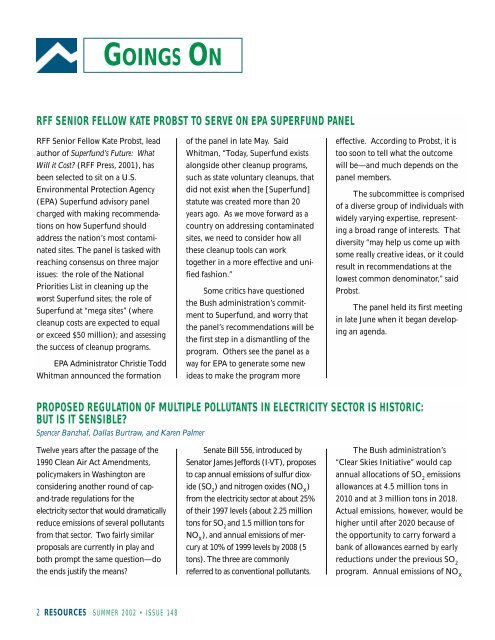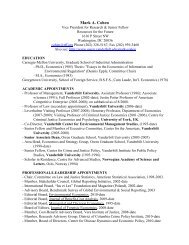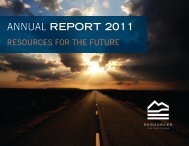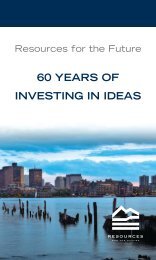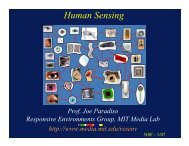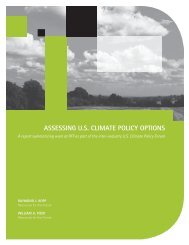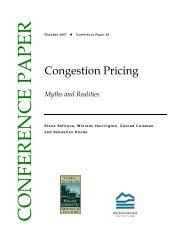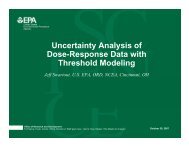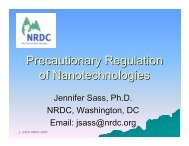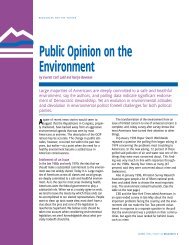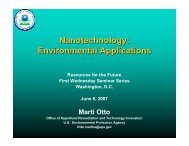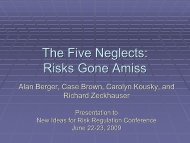Resources: Summer 2002; Issue 148 - Resources for the Future
Resources: Summer 2002; Issue 148 - Resources for the Future
Resources: Summer 2002; Issue 148 - Resources for the Future
You also want an ePaper? Increase the reach of your titles
YUMPU automatically turns print PDFs into web optimized ePapers that Google loves.
GOINGS ON<br />
RFF SENIOR FELLOW KATE PROBST TO SERVE ON EPA SUPERFUND PANEL<br />
RFF Senior Fellow Kate Probst, lead<br />
author of Superfund’s <strong>Future</strong>: What<br />
Will it Cost? (RFF Press, 2001), has<br />
been selected to sit on a U.S.<br />
Environmental Protection Agency<br />
(EPA) Superfund advisory panel<br />
charged with making recommendations<br />
on how Superfund should<br />
address <strong>the</strong> nation’s most contaminated<br />
sites. The panel is tasked with<br />
reaching consensus on three major<br />
issues: <strong>the</strong> role of <strong>the</strong> National<br />
Priorities List in cleaning up <strong>the</strong><br />
worst Superfund sites; <strong>the</strong> role of<br />
Superfund at “mega sites” (where<br />
cleanup costs are expected to equal<br />
or exceed $50 million); and assessing<br />
<strong>the</strong> success of cleanup programs.<br />
EPA Administrator Christie Todd<br />
Whitman announced <strong>the</strong> <strong>for</strong>mation<br />
of <strong>the</strong> panel in late May. Said<br />
Whitman, “Today, Superfund exists<br />
alongside o<strong>the</strong>r cleanup programs,<br />
such as state voluntary cleanups, that<br />
did not exist when <strong>the</strong> [Superfund]<br />
statute was created more than 20<br />
years ago. As we move <strong>for</strong>ward as a<br />
country on addressing contaminated<br />
sites, we need to consider how all<br />
<strong>the</strong>se cleanup tools can work<br />
toge<strong>the</strong>r in a more effective and unified<br />
fashion.”<br />
Some critics have questioned<br />
<strong>the</strong> Bush administration’s commitment<br />
to Superfund, and worry that<br />
<strong>the</strong> panel’s recommendations will be<br />
<strong>the</strong> first step in a dismantling of <strong>the</strong><br />
program. O<strong>the</strong>rs see <strong>the</strong> panel as a<br />
way <strong>for</strong> EPA to generate some new<br />
ideas to make <strong>the</strong> program more<br />
effective. According to Probst, it is<br />
too soon to tell what <strong>the</strong> outcome<br />
will be—and much depends on <strong>the</strong><br />
panel members.<br />
The subcommittee is comprised<br />
of a diverse group of individuals with<br />
widely varying expertise, representing<br />
a broad range of interests. That<br />
diversity “may help us come up with<br />
some really creative ideas, or it could<br />
result in recommendations at <strong>the</strong><br />
lowest common denominator,” said<br />
Probst.<br />
The panel held its first meeting<br />
in late June when it began developing<br />
an agenda.<br />
PROPOSED REGULATION OF MULTIPLE POLLUTANTS IN ELECTRICITY SECTOR IS HISTORIC:<br />
BUT IS IT SENSIBLE?<br />
Spencer Banzhaf, Dallas Burtraw, and Karen Palmer<br />
Twelve years after <strong>the</strong> passage of <strong>the</strong><br />
1990 Clean Air Act Amendments,<br />
policymakers in Washington are<br />
considering ano<strong>the</strong>r round of capand-trade<br />
regulations <strong>for</strong> <strong>the</strong><br />
electricity sector that would dramatically<br />
reduce emissions of several pollutants<br />
from that sector. Two fairly similar<br />
proposals are currently in play and<br />
both prompt <strong>the</strong> same question—do<br />
<strong>the</strong> ends justify <strong>the</strong> means?<br />
Senate Bill 556, introduced by<br />
Senator James Jef<strong>for</strong>ds (I-VT), proposes<br />
to cap annual emissions of sulfur dioxide<br />
(SO 2<br />
) and nitrogen oxides (NO X<br />
)<br />
from <strong>the</strong> electricity sector at about 25%<br />
of <strong>the</strong>ir 1997 levels (about 2.25 million<br />
tons <strong>for</strong> SO 2<br />
and 1.5 million tons <strong>for</strong><br />
NO X<br />
), and annual emissions of mercury<br />
at 10% of 1999 levels by 2008 (5<br />
tons). The three are commonly<br />
referred to as conventional pollutants.<br />
The Bush administration’s<br />
“Clear Skies Initiative” would cap<br />
annual allocations of SO 2<br />
emissions<br />
allowances at 4.5 million tons in<br />
2010 and at 3 million tons in 2018.<br />
Actual emissions, however, would be<br />
higher until after 2020 because of<br />
<strong>the</strong> opportunity to carry <strong>for</strong>ward a<br />
bank of allowances earned by early<br />
reductions under <strong>the</strong> previous SO 2<br />
program. Annual emissions of NO X<br />
2 RESOURCES SUMMER <strong>2002</strong> • ISSUE <strong>148</strong>


